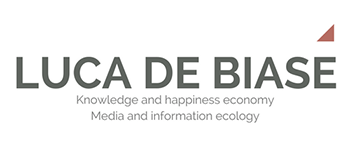All’Mit stanno studiando la fattibilità e le conseguenze di un approccio distribuito all’intelligenza artificiale. Un approccio che consenta da un lato di fare ricorso a un sistema distribuito di risorse e dall’altro di costruire un’architettura che invece di generare un potere fuori controllo estenda organicamente, naturalmente, l’intelligenza esistente in rete. Non per nulla all’Mit c’è anche il centro per lo studio dell’intelligenza collettiva. E soprattutto c’è il MediaLab guidato da Joi Ito (Extended intelligence):
Beyond distinguishing between creating an artificial intelligence (AI), or augmenting human intelligence (IA), perhaps the first and fundamental question is where does intelligence lie? Hasn’t it always resided beyond any single mind, extended by machines into a network of many minds and machines, all of them interacting as a kind of networked intelligence [10] that transcends and merges humans and machines?
If intelligence is networked to begin with, wouldn’t this thing we are calling “AI” just augment this networked intelligence, in a very natural way? While the notion of collective intelligence and the extended mind are not new ideas, is there a lens to look at modern AI in terms of its contribution to the collective intelligence?
We propose a kind of Extended Intelligence (EI), understanding intelligence as a fundamentally distributed phenomenon. As we develop increasingly powerful tools to process information and network that processing, aren’t we just adding new pieces to the EI that every actor in the network is a part of?
Il contributo di Joi Ito e dei suoi al dibattito che non è certo nuovo è quello di chi conosce molto bene la ricerca sull’interfaccia, il design umanistico-tecnico dell’interazione umano-macchina, anche per generare conoscenza sulle caratteristiche da valorizzare nell’organizzazione di comunità in modo che sia più intelligente dell’individuo (HDlab), o per indagare il computing affettivo, gli ambienti che interagiscono con gli umani, le modalità di una cooperazione scalabile e così via.
Riferimenti:
Dinakar, Karthik and Chen, Jackie and Lieberman, Henry and Picard, Rosalind and Filbin, Robert. “Mixed-Initiative Real-Time Topic Modeling; Visualization for Crisis Counseling“. ACM, (2015): 417–426.
T.P. Minka and R.W. Picard. “Interactive learning with a âsociety of models “. Pattern Recognition . Vol. 30. (1997): Num. 4. 565 – 581.
Singh, Push. “The Open Mind Common Sense Project“. KurzweilAI.net. (2002)
“Affective Computing‘s Publications”.
John Markoff. “A Fight to Win the Future: Computers vs. Humans“. The New York Times. (2011)
Nelson Hernandez. “Chess Festival in Benidorm – where a new genre is born“. Chessbase.com. (2007)
Andy Clark and David Halmers. “The Extended Mind“. Analysis. Vol. 58. (1998): Num. 1. 7-19. Inspired by the paper The Extended Mind
Cesar Hidalgo. “Networked Intelligence“. Pub Pub. (2016)





[…] Vedi il dossier Apple vs. FBI Vedi anche: Intelligenza estesa […]